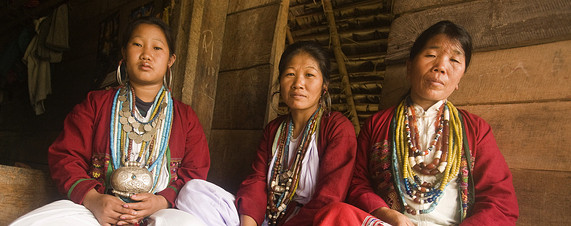
© Chris RainierThree speakers of a newly identified language known as Koro.
In the foothills of the Himalayas, two field linguists have discovered an oddity as rare as any endangered species - a language completely new to science.
The researchers, who announced their find Tuesday in Washington, D.C., encountered it for the first time along the western ridges of Arunachal Pradesh, India's northeastern-most state, where more than 120 languages are spoken. There, isolated by craggy slopes and rushing rivers, the hunters and subsistence farmers who speak this rare tongue live in a dozen or so villages of bamboo houses built on stilts.
The researchers identified the language - called Koro - during a 2008 expedition conducted as part of National Geographic's Enduring Voices project.
"Their language is quite distinct on every level - the sound, the words, the sentence structure," said Gregory Anderson, director of the nonprofit Living Tongues Institute for Endangered Languages, who directs the project's research. Details of the language will be documented in an upcoming issue of the journal
Indian Linguistics.
Prized for its rarity as an unstudied linguistic artifact, the Koro language also offers researchers a catalogue of unique cultural experience, encoded in its mental grammar of words and sentence structure that helps shape thought itself.
Languages like Koro "construe reality in very different ways," Dr. Anderson said. "They uniquely code knowledge of the natural world in ways that cannot be translated into a major language."
Of the 6,909 known languages, about half are expected to disappear in this century; every two weeks, the last fluent speaker of a language dies. This newest, with only 800 or so speakers, may be no exception.
"Even though this is new to science, this language is on the way out," said linguist K. David Harrison at Swarthmore College outside Philadelphia. Many younger villagers, often educated at boarding schools where only Hindi or English are spoken, are abandoning their parents' language. "Young people are not speaking it in the villages," Dr. Harrison said. "If the process continues, Koro will almost certainly become extinct."
As a matter of formal classification, Koro belongs to the Tibeto-Burman language family, a group of some 400 languages that includes Tibetan and Burmese, the linguists said. Some 150 Tibeto-Burman languages are spoken in India alone.
The language has no written form. Its only permanent monuments are the voice recordings made by the researchers during the expedition, which they hope to use in compiling an online dictionary of the tongue. The villagers so far, though, have no access to the Internet, so the dictionary and other digital records of Koro may only be of academic interest.
This newest addition to the global catalogue of known languages eluded notice until now because travel in the region is restricted by government permit and few linguists have ever worked there.
Moreover, it was masked by the unusual language diversity of the area, where so many languages are spoken that they seem to intermingle effortlessly in streams of thought. Indeed, the local Koro speakers themselves did not consider theirs a separate language, even though it is as distinct from those spoken by other villagers as English is from Russian, the researchers said.
The researchers hope their work will aid efforts to preserve the endangered language. "If we care about the diversity of ideas and knowledge, then we should be concerned about losing these languages," Dr. Harrison said. "We are losing an immense body of knowledge."
Reader Comments
to our Newsletter